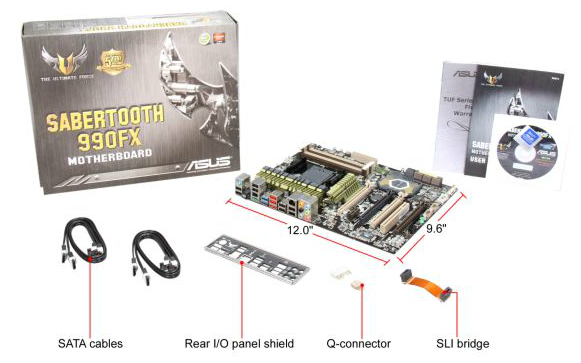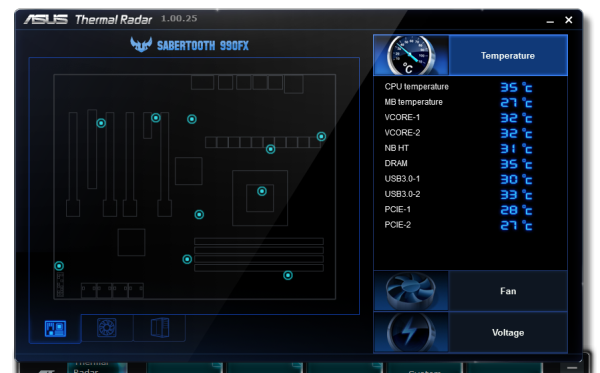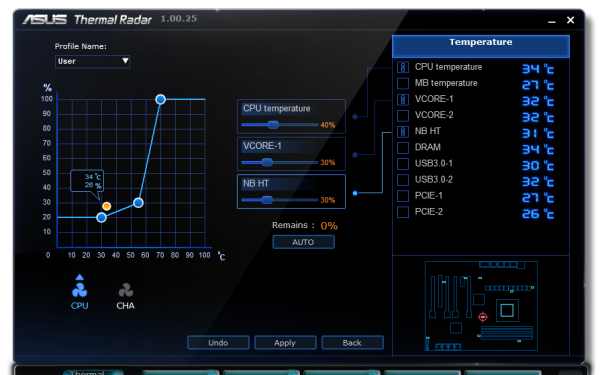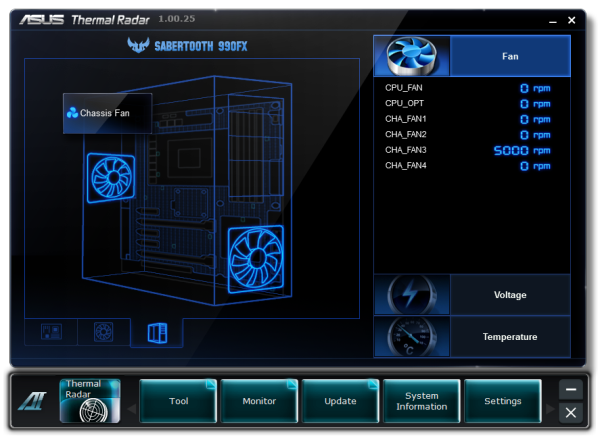990FX Motherboard Roundup with Thuban and Bulldozer – A Second Wind for ASUS, Gigabyte, MSI and Biostar
by Ian Cutress on April 5, 2012 11:00 AM ESTASUS Sabertooth 990FX In The Box
In comparison to the Crosshair V Formula, the Sabertooth does not come with as many goodies in the box. This may be indicative of the price difference (~$45 cheaper for the Sabertooth), and that part of the price of the Sabertooth is due to that five year warranty. In the box, we receive what I would deem the bare minimum for a product of this price:
IO Shield
Driver CD
User Guide
Four SATA Cables (Locking, right angled at one end)
Flexible SLI bridge
ASUS Q-Connector

Image Courtesy of Newegg
Board Features
| ASUS Sabertooth 990FX | |
| Price | Link to Newegg |
| Size | ATX |
| CPU Interface | AM3+ |
| CPU Support | AMD FX/Phenom II/Athlon II/Sempron 100 |
| Chipset | AMD 990FX |
| Base Clock Frequency | 200.66 MHz |
| Core Voltage | Auto, 0.675 V to 2.075 V |
| CPU Clock Multiplier | Auto, 4x to 35x |
| DRAM Voltage | Auto, 1.2 V to 2.5 V |
| DRAM Command Rate | Auto, 1T or 2T |
| Memory Slots |
Four DDR3 DIMM slots supporting up to 32 GB Up to Dual Channel Support for DDR3, 1066-1866 MHz, ECC or Non-ECC |
| Expansion Slots |
3 x PCIe Gen2 x16 (x16/x16 or x16/x8/x8) 1 x PCIe Gen2 x4 1 x PCIe Gen2 x1 1 x PCI |
| Onboard SATA/RAID |
6 x SATA 6 Gbps, Support for RAID 0, 1, 5, 10 2 x SATA 3 Gbps (JMicron JMB362) 1 x Power eSATA 3 Gbps 1 x eSATA 3 Gbps |
| Onboard |
6 x SATA 6 Gbps (Chipset) 2 x SATA 3 Gbps (JMicron JMB362) 6 x Fan Headers 2 x USB 2.0 Headers 1 x USB 3.0 Headers 1 x S/PDIF Output Header 1 x Front Panel Header 1 x COM Port Header 1 x Clear CMOS Header 1 x IEEE1394 Header 1 x MemOK! Button |
| Onboard LAN | Realtek 8111E |
| Onboard Audio | Realtek ALC892 |
| Power Connectors |
1 x 24-pin ATX connector 1 x 8-pin 12V connector |
| Fan Headers |
1 x CPU Fan Header (4-pin) 4 x CHA Fan Headers (one 4-pin, three 3-pin) 1 x OPT Fan Headers (4-pin) |
| IO Panel |
1 x Keyboard/Mouse PS2 Port 1 x Power eSATA 3 Gbps 1 x eSATA 3 Gbps 1 x IEEE1394 Port 1 x Gigabit Ethernet 2 x USB 3.0 10 x USB 2.0 1 x Optical SPDIF Output Audio Outputs |
| BIOS Version | 0901 |
| Warranty Period | 5 Years |
Instead of bleating continuously about that five year warranty, on the board we have a set of six fan connectors, and the SATA ports are bolstered by a SATA 6 Gbps controller in the form of the rarely seen JMicron JMB362. Lacking on the Sabertooth products are the Power/Reset buttons and two-digit debug LED which is unfortunate, plus there is extra space on the back panel for perhaps an extra network controller. The board uses also a Realtek NIC/Audio combination.
Software
ASUS Software revolves around its AI Suite package. This attempts to bring together all the features of the product into one interface, which for the most part is simple enough to use. One downside of the AI Suite software is on the DPC Latency, our audio test. This test performs a deferred procedure call and times how long it takes the system to process it – these calls are queued based on priority. The DP calls done by AI Suite as part of its sensor software have higher priority than audio, thus causing the DPC Latency to increase from ~200 microseconds (sub-500 is a good result), to over 2000 microseconds. Ideally this means that if you are expecting to record audio with an ASUS system, AI Suite should be switched off. I should note that other manufacturers are victims of this also – any vendor that includes sensor software as part of its package and by default causes it to boot with the operating system is liable to these spikes in performance for the DPC Latency test.
With that being said, AI Suite is good at what it does. As this is a Sabertooth product, we get Sabertooth specific features. Instead of the AI Tuner we normally get on an ASUS product, this is replaced by the Thermal Radar:
This integrated fan technology allows the user to associate fans connected on the board to certain temperature sensors. So a chassis fan at the back of the case directed air in or out can be connected to the CPU and VRM sensors (at a ratio determined by the user), and have its speed adjust appropriately using a customized multi-ramp speed profile. If you wanted customizability with your fans, ASUS has got it with their Sabertooth product.
Elsewhere on the AI Suite software is the TurboV Evo option, allowing the user to apply temporary overclocks until the system is restarted, and Digi+ VRM, giving the user control over the limitations of the power delivery on board (applicable to overclocked systems). AI Charger as part of the AI Suite gives extra current to a particular header on the motherboard, allowing it to charge your Apple device (iPod, iPhone or iPad) at a faster rate. Users can also update the BIOS through the AI Suite software.



















57 Comments
View All Comments
IanCutress - Thursday, April 5, 2012 - link
Unfortunately we don't have an infinite amount of kit to review with. We're individual reviewers here, not all working in a big office. Obviously we can't all request top end kit from manufacturers either. Plus for every time we do use new high end kit, we also get comments about testing something 'more realistic' to most users. In that circumstance, we can't win and please everyone, but we do try and be as consistent as possible.Ian
phocean - Thursday, April 5, 2012 - link
I bought the Sabertooth a few weeks ago... and it throws an annoying buzzing sound in the speakers, especially when a USB port is used (in other words, all the time).It is the sign of an isolation issue between chipsets and shows poor design and testing from Asus.
Needless to say that the support was of no help (and no willing to help).
So don't buy it, unless you don't plug any speaker in it.
richaron - Friday, April 6, 2012 - link
Mine doesn't have this problem. You either got an unlucky board, or your psu is funky.extide - Thursday, April 5, 2012 - link
Seem to me like you were probably using a bit too much voltage for the BD. I would assume that is why you had so many issues with thermal runaway. 1.4-1.45ish would probably be a better place to stay with an air cooler :)extide - Thursday, April 5, 2012 - link
EDIT: Nevermind I forgot you are using the AMD kit watercooler, which is better than straight air cooling but I'd think it would take more of a fully custom built water setup to run 1.5v vCore.Hrel - Thursday, April 5, 2012 - link
I was going to build a new computer based on Ivy Bridge this Fall, I'm still running a Core 2 Duo E8400. But I've decided I'm not building myself a new computer until the motherboard has USB 3.0 and ONLY USB 3.0. A LOT of them, EVERYWHERE!I just built a guy a Z68 based computer with an i7 2700K but I had to order a VERY hard to find adapter card to plug in the USB 3.0 based memory card reader and the USB 3.0 on the front of the Fractal Design case. Because the Asus motherboard has ZERO USB 3.0 headers on it. It never even occurred to me that was a possibility. Not only has USB 3.0 been out for years now, but it was released WAY over-due. WTF is the hold up. Make the switch. USB 2.0 is for the 2000's decade, it's 2012. I am done with USB 2.0. I shouldn't have to buy an add-in card for BRAND NEW motherboard to support basic accesories, like a memory card reader and front usb port.
This is related to this article because I think if AMD was actually competitive with Intel AT ALL, like they were with Athlon XP/64/64 X2, then Intel would step up their game all around. Or maybe I wouldn't even have to buy Intel because they constantly make shit decisions like this, and changing the motherboard socket constantly, and charging 300 dollars for a quad core with HT. Their shit is endless and I really don't want to buy their products but AMD is simply not an option; if I wanted something that slow I'd just put a quad core Penryn based CPU in my current rig and save a bunch of money.
ggathagan - Friday, April 6, 2012 - link
There are only two Asus Z68 boards that don't have the USB 3 header, but somehow it's *Intel's* fault that Asus didn't use a USB 3 header on the board you bought?Huh...
Maybe you should have been a little more attentive when board shopping.
IanCutress - Friday, April 6, 2012 - link
Hi Hrel,I actually like USB 2.0 on my boards. If you have solely USB 3.0 and use them all, there's a big chance of a bottleneck in the bus somewhere. Also, I install a fresh operating system on every board I test via USB as it is a lot quicker than CD. Unfortunately during the install program, it doesn't process anything through the USB 3.0 ports - mouse, keyboard, or even the USB stick with the OS on. So I ideally like to have three USB 2.0 ports for that purpose. It's more a fault of Windows7 than the chipset, but otherwise if a board only has two USB 2.0 ports, I have to disconnect the mouse and use the keyboard and USB install drive only. Saying that, I have a board in that is solely USB 3.0, so it's going to be fun to install an OS on that... :/
Ian
fic2 - Friday, April 6, 2012 - link
I have a Dell keyboard that has 2 USB ports on it. That would solve your problem with a 2 x USB 2 mb. I currently have the mouse daisy chained off the keyboard.B - Thursday, April 5, 2012 - link
Your article should note that sound blaster provides a software overlay, but under that aluminum skin overlay lies a Realtek chip. I was fooled by this marketing and very disappointed after configuring this motherboard and discovering this fact. You don't get soudblasters hardware acceleration or the crystalizer. You should note this in any article about the asus line with x-fi2. Had I known I would have done things differently.